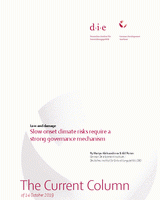Loss and damage
Slow onset climate risks require a strong governance mechanism
Aleksandrova, Mariya/ Idil BoranThe Current Column (2019)
Bonn: German Development Institute / Deutsches Institut für Entwicklungspolitik (DIE), (The Current Column of 14 October 2019)
Bonn, 14.10.2019. Weather extremes and rapid onset disasters that result from global warming, like floods, hurricanes and heat waves, occupy increasing space in the media and in policy debates. Slow onset impacts, however, such as sea level rise, ocean acidification, glacial retreat, salinization, desertification, land and forest degradation and loss of biodiversity, also have long-term consequences that cannot be overlooked. In 2013, Parties to the United Nations Framework Convention on Climate Change (UNFCCC) acknowledged the increasing risks related to climate change and established the Warsaw International Mechanism for Loss and Damage (WIM). The WIM provides technical assistance to developing countries in order to avoid, minimize and address residual loss and damage from extreme weather and slow onset climate events. Next week, the Executive Committee (ExCom) of the WIM meets in Bonn to discuss, among other things, how best to coordinate its activities under the UNFCCC. This is a pivotal meeting, held weeks before the WIM undergoes a scheduled review of its structure, mandate, and effectiveness at the UN Climate Change conference (COP25) in Chile in December.
A suite of recent scientific reports, notably from the Intergovernmental Panel on Climate Change (IPCC), make alarmingly clear assessments of observed and potential climate change impacts. The 2018 Special Report on the Impacts of Global Warming of 1.5 °C shows a stark difference between global warming of 1.5 °C versus 2 °C. This year’s Special Report on Climate Change and Land provides an assessment of loss of productive land due to desertification and extreme soil erosion, disrupted food chains and threatened livelihoods. The most recent Special Report on the Ocean and Cryosphere in a Changing Climate sheds light on the consequences of large losses from ice sheets and glaciers, shrinking snow cover and Arctic sea ice, rising permafrost temperature, and their effects on human communities. Additionally, the current report of the Intergovernmental Science-Policy Platform on Biodiversity and Ecosystem Services (IPBES) discusses the cascading effects of rapid deterioration of nature and biodiversity. What these reports converge on is the need for urgent action to build resilience – not only against rapid onset extremes but also gradual effects of a changing climate.
Even if global warming is kept to 1.5 °C, risks of loss and damage from slow onset processes remain. Associated economic and non-economic impacts on poverty, health and human security have long-term implications for sustainable development. Moreover, social, economic and political factors, e.g. the use and management of land and water resources, are an integral part of the risk equation. Already, marine, terrestrial and freshwater ecosystems bear the brunt of the cumulative effects of overexploitation and pollution. These effects exacerbate the risks of loss and damage from slow onset processes.
An integrated, coherent, coordinated and long-term approach to climate risk management is needed in order to face the complexity of risks and multiplicity of response options to slow onset events. This is also reflected in Article 8 of the Paris Agreement, which calls for “the role of sustainable development in reducing the risk of loss and damage”. Actions to mitigate loss and damage should be consistent with Sustainable Development Goals (SDGs) and also with further processes and institutions that shape climate and development policy today.
However, the WIM currently lacks linkages to other international processes and institutions. Sooner rather than later, the WIM will need to align with multiple frameworks, such as (1) Land Degradation Neutrality under the United Nations Convention to Combat Desertification (UNCCD), (2) the Aichi targets under the Convention on Biological Diversity (CBD) and, crucially, (3) the 2030 Agenda for Sustainable Development. Strong linkages can help galvanize responses to the risks associated with slow onset events with benefits on multiple indicators, such as health, clean water, land productivity and biodiversity. Engaging a broad range of actors from local to regional levels, including the private sector, public-private partnerships, cities and regions, will also be central to successful implementation.
With next week’s meeting of its Executive Committee and the upcoming review at COP25 in Chile, the WIM is entering a critical juncture. A debate around a strengthened governance mechanism with substantive linkages between loss and damage policy and the wider development architecture of the United Nations will be critical to enable national level action in response to slow onset climate risks. The imminent WIM review presents a timely opportunity – it should not be missed.


